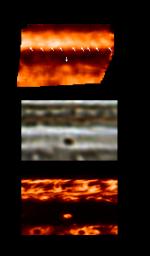A recently discovered black spot in Jupiter's clouds is darker than any feature ever before observed on the giant planet. The spot may be the result of a downward spiraling wind that blows away high clouds and reveals deeper, very dark cloud layers. These three panels depict the same area of Jupiter's atmosphere. A map of Jovian temperatures near 250 millibar pressure (top) panel is derived from the photopolarimeter-radiometer instrument on NASA's Galileo Jupiter orbiter. This map is compared with maps derived from images of the same area in visible light (middle panel) and thermal radiation sensitive to cloud-top temperatures (bottom panel).
The single downward-pointing arrow in the top panel indicates the location of a warm area that corresponds to the position of a so-called "black spot"(shown in the middle panel), a feature that is about a year old. Features this dark are rare on Jupiter. The bottom panel, sensitive to temperatures at Jupiter's cloud tops, shows this feature as a bright object, meaning that upper-level cold clouds are missing - allowing us to see deeper into Jupiter's warmer interior. The dark visible appearance of the feature than most likely represents the color of very deep clouds. The warm temperatures and cloud-free conditions imply that this feature is a region where dry upper-atmospheric gas is being forced to converge, is warmed up and then forced to descend, clearing out clouds. It is the opposite of wet, upwelling gas in areas such as Jupiter's Great Red Spot or white ovals. On the other hand, it is unlike the dry and relatively cloudless feature into which the Galileo probe descended in 1995, because that region had the same temperatures as its surroundings and did not appear nearly as dark as this new [sic]spot.
The temperatures sampled by the photopolarimeter radiometer are near the top of Jupiter's troposphere, where wind motions control the atmosphere. The top row of arrows shows the location of temperature waves in a warm region of the atmosphere. These types of waves have never been seen before. What is interesting about these waves is both that they are "channeled" within the warm band at the top of the panel, and that they appear to have no counterpart in the visible cloud structure. Thermal waves have already been seen in Jupiter that are independent of the cloud structure, but those waves were much larger in size. This is the first time Jupiter's temperatures have been mapped at a spatial resolution better than 2,000 kilometers (1,243 miles), allowing these waves to be detected.
These maps include an area on Jupiter between approximately the equator and 40 degrees south latitude, covering about 60 degrees of longitude. They were taken in late September during the spacecraft's 17th orbit.
The Jet Propulsion Laboratory, Pasadena, CA manages the Galileo mission for NASA's Office of Space Science, Washington, DC.

 Planetary Data System
Planetary Data System












